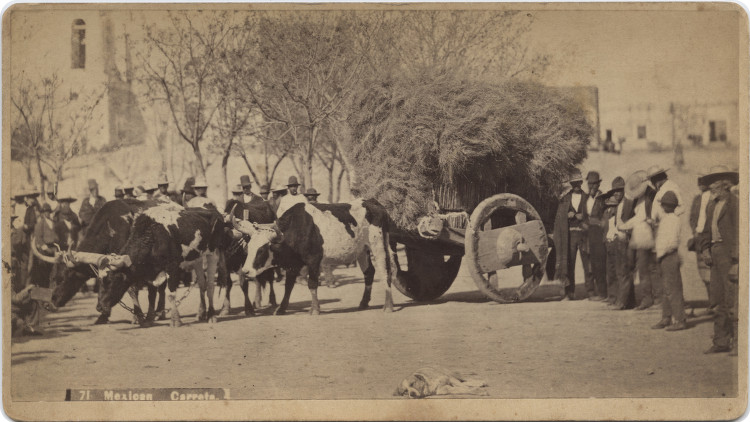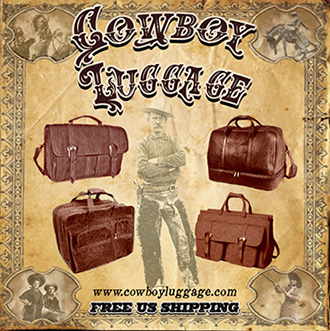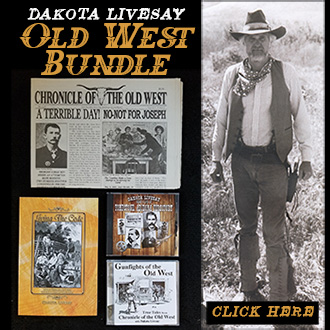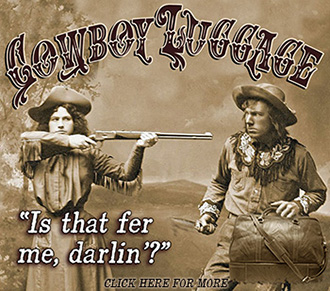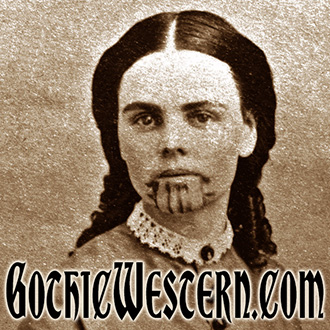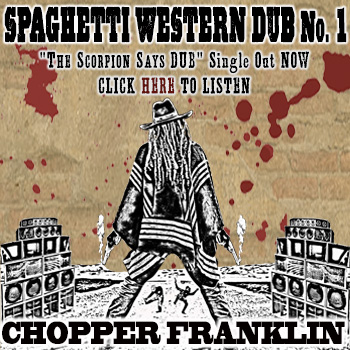Crime of ’73

Joel Fowler – A Vigilante Hanging
 Joel Fowler was born in Maryland, and he later migrated down to Texas. He spent some time on the stage as an actor and entertainer. Not able to earn much of a living at this profession, he tried his hand as a law attorney. Running abreast of the law, in 1879 Joel headed up to New Mexico. But this was still not someone who one would think would end up on the wrong end of a vigilante hanging.
Joel Fowler was born in Maryland, and he later migrated down to Texas. He spent some time on the stage as an actor and entertainer. Not able to earn much of a living at this profession, he tried his hand as a law attorney. Running abreast of the law, in 1879 Joel headed up to New Mexico. But this was still not someone who one would think would end up on the wrong end of a vigilante hanging.Denver’s First Trial

The Cowboy Kid

Christmas Day 1890
Christmas Day 1890. How the Various Churches Will Observe the Festival.
There will be Services Appropriate to the Season and in Most of the Churches Special Music.
 December 24, 1890, Daily, Woodland, California – In all of the churches of this city Christmas day will be fittingly observed. The sermons and in most of the churches there will be special musical service.
December 24, 1890, Daily, Woodland, California – In all of the churches of this city Christmas day will be fittingly observed. The sermons and in most of the churches there will be special musical service.
At St. Luke’s Church the quartette choir of St. Luke’s will give a full musical service appropriate to Christmas day, tomorrow morning at 11 o’clock. The choir is composed of Della Prior-Pierce, Minnie Prior, Wilbur Blair and C. W. Bush; Maggie Ellis, organist. Mrs. Pierce will sing the solo to the beautiful anthem of Williams’. “There Were Shepherds Abiding in the Fields,” and Adolf Adams’ famous “Noel” for the offertory.
Dudley Buck’s festival Te Deum will be a feature of the service.
All are cordially invited to be present. Sunday school at 10 o’clock.
There will be special services in the Congregational Church both morning and evening. Rev. Joel Martin will preach at 11 o’clock. Mr. Martin is well known in the East as an earnest, logical and attractive speaker. Since coming to this coast he has held very successful meetings in Oakland, where large audiences have greeted him in the several churches where he has spoken. At 7 p.m. there will be special children’s Christmas concert service in which the children will take an active part and Mr. Martin will speak. Special music has been prepared. On the afternoons and evenings of Tuesday, Wednesday and Thursday Mr. Martin will also hold services in the church. A cordial invitation is extended to all to attend these services.
The services at the Christian Church tonight will be an old-fashioned Christmas tree. A short program will be given by the Sunday school at 7:30 o’clock. The tree will be beautifully decorated, as the young ladies of the church are sparing no pains to make it the most attractive and interesting that they have ever given. The service tomorrow will be of a special nature. Miss Mary Browning will sing “The New Born King” at the morning service. Special music by the choir in the evening. Subject of the morning sermon at the Baptist Church tomorrow, but there will be a meeting of the young people and Sunday school at the usual hours. The Sunday school children will give an entertainment this evening, after which a Christmas tree will be utilized to distribute the favors of good Santa Claus.
At the Church of the Holy Rosary the first mass will be celebrated at 8 o’clock and the second mass at half past 10. The pupils of Holy Rosary Academy will render appropriate Christmas hymns and carols.
At the M. E. Church Rev. J. A. Van Anda will preach Christmas sermons at 11 o’clock in the morning and 7:30 p.m. The music will be of an appropriate character. This evening there will be a Christmas tree in the church to which all friends are invited.
The pastor, Rev. C. O. Steele, will preach a Christmas sermon at the M. E. Church south at 11 a.m. There will also be other appropriate services. The Sabbath school will begin at 10 a.m. At 6:15 the league will meet.
The Second Christian Church will hold Christmas tree exercises next Monday evening.
At the German Church there will be a musical and literary program and a Christmas tree, and tomorrow Rev. J. Endter will preach a Christmas sermon and there will be special music.
Train – Oxcart Race
Women’s Suffrage

The Great Diamond Hoax
 With the discovery of gold in California fake gold and silver mines became common. Swindlers and con men fooled many a greenhorn with “salted” mines. But there were few con men who did as great a job as two cousins from Kentucky named Philip Arnold and John Slack. They perpetuated the Great Diamond Hoax.
With the discovery of gold in California fake gold and silver mines became common. Swindlers and con men fooled many a greenhorn with “salted” mines. But there were few con men who did as great a job as two cousins from Kentucky named Philip Arnold and John Slack. They perpetuated the Great Diamond Hoax. A young geographical surveyor by the name of Clarence King was suspicious of the stories he heard about the mine. It took one visit to the mine to realize it had been salted… Some of the gems he found had already been cut by a jeweler.
A young geographical surveyor by the name of Clarence King was suspicious of the stories he heard about the mine. It took one visit to the mine to realize it had been salted… Some of the gems he found had already been cut by a jeweler.Transcontinental Telegraph

Thomas Bowe
 Thomas Bowe was a slightly built man, who stood about 5 foot 6 inches. He had a hair trigger, both personally and gun-wise. With a mysterious background that supposedly included murder and stagecoach robbery, Thomas showed up in Silver City, New Mexico during the winter of 1874.
Thomas Bowe was a slightly built man, who stood about 5 foot 6 inches. He had a hair trigger, both personally and gun-wise. With a mysterious background that supposedly included murder and stagecoach robbery, Thomas showed up in Silver City, New Mexico during the winter of 1874.Chief Geronimo and His Braves
 September 2, 1894, Daily Star, Tucson, Arizona – A dispatch sent out from Chicago is that old Geronimo and his band of Apache savages, who have been prisoners at Mount Vernon barracks, Alabama for a long time, are to be removed to Fort Sill, O. T. Secretary Fairmont has ordered their return to the west, and Captain Marion T. Maus, one of the officers on duty at General Miles’ headquarters in Chicago, has gone, it is said, to Alabama to personally direct the transfer. The Indians, to the number of nearly 300, will be taken to Fort Sill, and after a period of surveillance there, will be returned to their old reservation in the mountains of eastern Arizona.
September 2, 1894, Daily Star, Tucson, Arizona – A dispatch sent out from Chicago is that old Geronimo and his band of Apache savages, who have been prisoners at Mount Vernon barracks, Alabama for a long time, are to be removed to Fort Sill, O. T. Secretary Fairmont has ordered their return to the west, and Captain Marion T. Maus, one of the officers on duty at General Miles’ headquarters in Chicago, has gone, it is said, to Alabama to personally direct the transfer. The Indians, to the number of nearly 300, will be taken to Fort Sill, and after a period of surveillance there, will be returned to their old reservation in the mountains of eastern Arizona.
The Indians, after their capture in March, 1886, by regular troops under General George Crook, escaped and were subsequently retaken by General miles, who had relieved Crook. The cut throats, after their capture, were taken as prisoners of war to Florida.
They were confined there for sometime, but owing to the injurious effects of the climate upon the Indians they were removed to Mount Vernon barracks, about twenty-five miles from Mobile. Here the climate was no better, and many of the Indians died from consumption and other pulmonary diseases. They had been used to the dry air of the plains and the humidity and warmth brought on illness. From 500 or 690 the band has been reduced to less than 300, and their removal is now made in the interests of humanity.
General Crook before his death made strenuous efforts to bring about the removal of these Indians to their new home, and he argues that long imprisonment and suffering had broken them in spirit and taken out of them all desire to renew their former savagery Four years ago a movement looking to their transfer was inaugurated, but the moment it became known the people of Arizona and New Mexico sent a delegation of citizens here to protest. The attempt was then abandoned, and it was not renewed until lately.
The matter was called up in congress a few months ago and a provision was inserted in the Indian appropriation bill setting apart a sufficient sum for removal of these Indians to “one of the territories.” No place was specified and the provision was passed, in spit of Delegates Smith of Arizona, Joseph of New Mexico and Flynn of Oklahoma.
It is in accordance with the provision of the recently approved Indian appropriation bill that Captain Maus, order direction of the war department, will now conduct the Indians from the scene of their long imprisonment. They will be taken to Fort Sill, which is near the center of the Kiowa, Comanche and Apache reservation in the southern part of Oklahoma Territory. It is probable that the citizens of Oklahoma will protest, but as Fort Sill is pretty well garrisoned their need be no fear of an Indian outbreak, even with Geronimo’s band quartered there. Some time this fall it is expected that the band will be returned to Arizona.
So far no action whatever has been taken by the people of Arizona with reference to the removal of Geronimo and his band to Fort Sill. It is not likely that any protest will be made, that being the opinion of the oldest citizens interviewed on the subject that little is to be feared from the return of the band after so long an absence in the south. None of theses oldtimers hesitated in saying that they do not apprehend that these Indians would make any attempt to reach their old haunts from Fort Sill. Geronimo is an old man now and the time is not far distant when he will go to join on the happy hunting grounds the braves gone before him. His hair is turning gray, his shoulders are stooped and his step far from being as firm as in the days he and his followers roamed over Arizona striking terror to the hearts of the settlers. Then, again, it is said he has undergone a change of heart, the old renegade of late years having acted as superintendent of a Sunday school at the old historical Alabama fort. But an Apache is an Apache; he’s not a good Indian till he’s dead.
The Springfield Rifle
“I would rather be shot by a Krag-Jorgensen or Mauser bullet than a Springfield rifle projectile,” said Captain Robert R. Stevens, quartermaster for Fort Sam Houston, to a Light reporter who questioned him yesterday as to the effectiveness of the various bullets.
The query was made by the reporter in view of the many criticisms published regarding the arming of Uncle Sam’s volunteers with Springfield rifles Captain Stevens was selected to explain the difference from the fact that the reporter knew he has spent many years in the west in the army when the Springfield rifle was in use and has also had experience in the army with the new gun. Captain Stevens has seen the old Springfield used on the Indians with deadly effect, and although he did not say so, it is a well known fact that the captain has used them on the red skins himself. When speaking of the use to which he had put the guns the captain invariably spoke of shooting deer, or animals of some kind, but his acquaintances know that during his seventeen years of duty as a lieutenant of the Sixth infantry, which is known to have had some hot Indian engagements, that he did not put in all his time shooting deer and wild turkeys.
Nevertheless the captain modestly acknowledged that he knew something about the Springfield rifle and with his usual courtesy, proceeded to compare the guns.
“The Springfield hasn’t the range of the Manser or Krag-Jorgensen, that is true,” said he, “but when a regiment gets close enough to an enemy for the Springfield to reach them they will make it warm for somebody.
“When a Springfield bullet strikes an object it makes a hole and doctors are rarely over puzzled over the outcome. They generally order funeral arrangements for the wounded man.”
“On the contrary the small steel bullet of the Krag-Jorgensen or Mauser rifle only pierces a very small hole and the result is not always fatel. It goes with such force at close range that it goes through a man easily and does not spread out like the lead bullet of the Springfield and makes a hole like a dynamite cartridge.”
“Take for instance wounding of Cadet Howel, of the Rough Riders, as mentioned in your paper of Monday. He was shot through and through with a Mauser bullet and is now able to be on the streets in Washington, scarcely three weeks after being wounded. If it had been a Springfield bullet he would now have been occupying a space in Cuban soil with a pine board marking his resting place. The surgeons would never have been puzzled as to the result of his wound when they examined him, as they were over the Mauser wound.”
“I have had experience with the Krag-Jorgensen and the Springfield rifles out west on hunting expeditions and it was there I noticed the difference. When I hit a deer with a Springfield he dropped, but many a time have I seen a deer run off apparently unhurt when it had been shot through and through by a Krag-Jorgensen bullet.
“I have never had the opportunity to see the result of a man being shot by a Krag-Jorgensen in an engagement, but I have seen Indians who were shot with Springfields. When they were hit once they did not trouble us any more.
“If I had to take my choice of weapons to be shot with I would never choose a Springfield. A man shot with one of those old lead spitters had better prepare his will and give his funeral directions.
“I think also that in actual battle if the Krag-Jorgensen is used as rapidly as it will work that the weapon would soon become too hot to handle and the Springfield which is not operated with such rapidity has the advantage of keeping cool. It is impossible for a man with a rapid firing gun to shoot slow in the excitement of battle and the only way to keep his gun so he can handle it is to give him one that does not shoot so fast. This is a Springfield.
Tombstone, Arizona Territory
 TOMBSTONE, ARIZONA TERRITORY. As the story goes, Ed Schieffelin, while prospecting in southeast Arizona, was told that all he would be able to find would be his tombstone. What Schieffelin found was an area that ended up producing $30 million in silver. On September 3, 1877, he recorded his claim, jokingly naming it the Tombstone Mine.
TOMBSTONE, ARIZONA TERRITORY. As the story goes, Ed Schieffelin, while prospecting in southeast Arizona, was told that all he would be able to find would be his tombstone. What Schieffelin found was an area that ended up producing $30 million in silver. On September 3, 1877, he recorded his claim, jokingly naming it the Tombstone Mine.
History Of The Santa Fe Trail – Pt 1
 A party of young men, Hugh Stephenson, Lewis Dutton, Lucas Doane, Joshua Sledd, James Kirker, Robert McNight, Henry Corlew and Esteven Chushie, who in 1830, “made the Santa Fe trail and marked the route followed by thousands in after years.” That they marked the route is contradicted by Gregg’s Commerce of the Plains, as also by Niles Register. Fifteen thousand dollars worth of merchandise from St. Louis, Missouri, was delivered in Santa Fe in 1822, and the traffic had increased to $120,000 in 1830, the year in which the Las Cruces Republican claims Hugh Stephenson and others made the trail. All of this marks the history of the Santa Fe Trail.
A party of young men, Hugh Stephenson, Lewis Dutton, Lucas Doane, Joshua Sledd, James Kirker, Robert McNight, Henry Corlew and Esteven Chushie, who in 1830, “made the Santa Fe trail and marked the route followed by thousands in after years.” That they marked the route is contradicted by Gregg’s Commerce of the Plains, as also by Niles Register. Fifteen thousand dollars worth of merchandise from St. Louis, Missouri, was delivered in Santa Fe in 1822, and the traffic had increased to $120,000 in 1830, the year in which the Las Cruces Republican claims Hugh Stephenson and others made the trail. All of this marks the history of the Santa Fe Trail.
Freight was carried by pack animals until 1824, when wagons were introduced as an experiment, and making the trip without difficulty, were used exclusively after 1825. In January of that year, through the influence of Col. Thomas H. Benton, of Missouri, a bill was passed by congress authorizing the marking out a road. Thirty thousand dollars was appropriated for that purpose and that of obtaining the Indians’ consent to the road and its unmolested use. The U. S. Commissioners appointed to conduct the survey were Benjamin Reeves, George C. Sibley and Thomas Maher; and Joseph C. Brown as surveyor.
In 1825 a party left Santa Fe in June and in Franklin, Missouri, in August, with 500 mules and horses, and “the Santa Fe trade” continued to grow without intermission until the present time. But not without interruption from the Indians, which caused the committee on military affairs to report to congress, in 1828, in favor of a movable escort rather than a fixed garrison. The recommendation was given effect in 1829, and Major Riley, with four companies of the 6th infantry, from Fort Leavenworth, were detailed as the escort. Protection was not continued the following year; nevertheless, there was an increase in traffic of just 100 per cent over the preceding year.
In 1821 the Santa Fe trade may be said to have become a business proposition. Captain Glenn, Mr. Bicknell and Stephen Cooper were the pioneers of that commercial enterprise, although small parties of trappers and traders had previously visited Santa Fe. In 1815 Auguste P. Choteau and Julius de Mun formed a partnership and went with a large party Upper Arkansas to hunt, trap and trade with the Indians. The following year they visited Taos and Santa Fe, and were well received by Governor Mainez. But there was a change of policy the following year on the part of Mexican government, perhaps for the reason that the “gringos” were becoming too numerous, monopolizing the fur trade, killing the buffaloes for their skins, and making merchandise of buffalo tongues, a luxury in the states, even then in the frontier village of St. Louis they commanded a dollar each.
Jack Harris
 As a young man, Jack Harris was a scout for the army, and he fought in revolutions in Central American. Returning to America, he hunted buffalo, served as a policeman, and did some serious gambling.
As a young man, Jack Harris was a scout for the army, and he fought in revolutions in Central American. Returning to America, he hunted buffalo, served as a policeman, and did some serious gambling.John Wesley Hardin Kills a Town
 There are several great stories about John Wesley Hardin, one of the Old West’s best-known outlaws. One is how he hunted down and killed Juan Bideno. When Hardin told the story, he said he found Bideno in Bluff City. The town was actually Sumner City, and the story is how John Wesley Hardin kills a town .
There are several great stories about John Wesley Hardin, one of the Old West’s best-known outlaws. One is how he hunted down and killed Juan Bideno. When Hardin told the story, he said he found Bideno in Bluff City. The town was actually Sumner City, and the story is how John Wesley Hardin kills a town .Texas Ranger Frank Jones
 Born in Austin, Texas in 1856, Frank Jones joined the Texas Rangers at the age of 17. He saw his first action when he and two other Rangers were sent after some Mexican horse thieves. In the process, the horse thieves ambushed the Rangers. Frank’s two companions were immediately taken out, but Frank was able to kill two of the bandits and capture a third.
Born in Austin, Texas in 1856, Frank Jones joined the Texas Rangers at the age of 17. He saw his first action when he and two other Rangers were sent after some Mexican horse thieves. In the process, the horse thieves ambushed the Rangers. Frank’s two companions were immediately taken out, but Frank was able to kill two of the bandits and capture a third.Wilcox Train Robbery
In 1899, Butch Cassidy and the Wild Bunch were going full tilt. The Wild Bunch may have even divided into two groups, one specializing in banks, and the other in trains. Whether it was by the whole gang or just the train specialists, on June 2, 1899 the Overland Flyer was stopped in the area of Wilcox, Wyoming. Therein lies the story of the Wilcox Train Robbery.
They placed a red lantern on the track just in front of a wooden bridge. Thinking the bridge out, the train ground to a halt. Now, if it were the “train specialists,” they needed more “training” so to speak… because from this point forward things didn’t go well.
They wanted the engineer to pull the train to the other side of the bridge, so they could blow up the bridge. He refused; was pistol-whipped… and still he refused. Finally one of the wild bunch had to do it. After blowing the bridge, they approached the express car. A messenger named Woodcock guarded the car. He refused to open the door.
A well-placed stick of dynamite blew off one side of the car, and rendered Woodcock barely conscious. With Woodcock unable to open the safe, another stick of dynamite was put to the safe. The safe blew apart sending $30,000 flying through the air, and the robbers scrambling after the money.
Now, about the marked money… As the Wild Bunch picked up the money, they noticed it had a red stain on it. At first they though it was blood. But, it turned out to be from a crate of raspberries that was next to the safe. I can only imagine the telegrams sent to banks in the area. “Be on the lookout for money with burnt edges and the taste of raspberries.”

Both Officer and Highwayman Shot to Death
 July 28, 1896, Record-Union, Sacramento, California – The daring and mysterious outlaw who has terrorized this section of the State for the past six weeks, holding up travelers, singly and in groups, in broad daylight and without any attempt at disguise, was run to earth by Sheriff Douglass of this city yesterday afternoon, and in the duel which followed both Sheriff and highwayman were shot to death.
July 28, 1896, Record-Union, Sacramento, California – The daring and mysterious outlaw who has terrorized this section of the State for the past six weeks, holding up travelers, singly and in groups, in broad daylight and without any attempt at disguise, was run to earth by Sheriff Douglass of this city yesterday afternoon, and in the duel which followed both Sheriff and highwayman were shot to death.
Posse after posse had been dispatched on the trail of the road agent, but he eluded them all and continued his work of impoverishing the traveling public day by day without molestation. Becoming discouraged over the failure of his deputies. Sheriff Douglass determined to hunt the robber single handed. Accompanied only by his dog, the brave officer set out yesterday morning. Nothing was heard from him during the day. This morning his dog returned home, and the Sheriff’s friends became anxious. A search party was organized, and in a short time the officer’s horse and buggy were found by the roadside a few miles from the city. Half a mile distant in the bushes the bodies of the Sheriff and the outlaw were discovered within a few feet of each other, both rigid in death.
The robber had been shot three times, one of the bullets entering his heart. Upon examination it was found that the brave officer had received his death wounds from the rear, evidently at the hands of the robber’s confederate. The outlaw’s camp was discovered, and showed traces of having been occupied by two men.
Fresh posses were immediately organized, and late this evening word was brought to the city that the murderer had been carefully surrounded in the woods and would undoubtedly be taken. Lynching is certain to follow his capture, as Sheriff Douglass was an exceptionally popular officer, and his friends are enraged and determined to avenge the assassination.
The dead outlaw has been identified by several of his victims, but otherwise his personality remains a mystery.
LATER —No further advices have been received to-night from the numerous posses of Deputy Sheriffs and citizens engaged in the search tor Sheriff Douglas’ supposed assassin. The city presents an unusually lively appearance tonight, the streets being thronged with crowds of anxious citizens, eagerly awaiting news from the scene of the tragedy. The dead outlaw has been identified by M. L. Marsh as a man who worked in his sawmill during the month of May last. While in Marsh’s employ he passed as C. Meyers.
Under Sheriff Pascoe, who went out this morning to search for Sheriff Douglass, had not returned at 11 o’clock tonight, and grave fears are entertained that he may have been ambushed and slain. A large posse has been formed to search for him. It is hardly probable that Pascoe would have remained out so long if something had not happened. He is a son of the late W. H. Pascoe, who was killed by Fredericks three years ago while Sheriff of this county.
Dr. Tricknell conducted a post-mortem examination over the bodies of Sheriff Douglass and the outlaw to night. He said the men had been dead fifteen hours.
The rifle used by the robber was stolen from Grant Dart of Rough and Ready, eight miles from here. The dead robber worked for two days at Marsh’s sawmill in this town and also worked for two days at Lord’s livery stable in Grass Valley. He was seen in this city last Friday evening. He drank heavily. No one identified him as the tool-taker.
The murderer of Sheriff Douglass had robbed both his victims and the dead outlaw of all their clothing had been turned inside out, and everything they contained removed.
Bloody Prize Fight in Dodge City
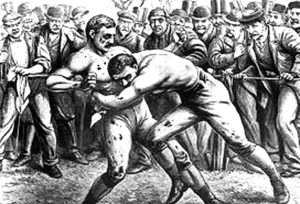 June 16, 1877, Times, Dodge City, Kansas – On last Tuesday morning the champion prize fight of Dodge City was indulged in by Messrs. Nelson Whitman and the noted Red Hanley, familiarly known as ‘the red bird from the South: An indefinite rumor had been circulated in sporting circles that a fight was to take place, but the time and place was known only to a select few. The sport took place in front of the Saratoga, at the silent hour of 4:30 a. m., when the city police were retiring after the dance hall revelry had subsided, and the belles who reign there were off duty. Promptly at the appointed time, the two candidates for championship were at the joint. Col. Norton acted as rounder up and whipper-in for both fighters, while Bobby Gill ably performed the arduous task of healing and handling and sponging off. Norton called “time,” and the ball opened with some fine hits from the shoulder.
June 16, 1877, Times, Dodge City, Kansas – On last Tuesday morning the champion prize fight of Dodge City was indulged in by Messrs. Nelson Whitman and the noted Red Hanley, familiarly known as ‘the red bird from the South: An indefinite rumor had been circulated in sporting circles that a fight was to take place, but the time and place was known only to a select few. The sport took place in front of the Saratoga, at the silent hour of 4:30 a. m., when the city police were retiring after the dance hall revelry had subsided, and the belles who reign there were off duty. Promptly at the appointed time, the two candidates for championship were at the joint. Col. Norton acted as rounder up and whipper-in for both fighters, while Bobby Gill ably performed the arduous task of healing and handling and sponging off. Norton called “time,” and the ball opened with some fine hits from the shoulder.
Whitman was the favorite in the pools, but Red made a brilliant effort to win the champion belt. During the forty second round, Red Hanley implored Norton to take Nelson off for a little while till he could have time to put his right eye back where it belonged, set his jaw bone and have the ragged edge trimmed off his ears where they had been chewed the worst. This was against the rules of the ring, so Norton declined, encouraging him to bear it as well as he could and squeal when he got enough. About the sixty-first round, Red squealed unmistakably, and Whitman was declared winner. The only injuries sustained by the loser in this bloody prize fight were two ears chewed off, one eye busted and the other disabled, right cheek bone caved in, bridge of the nose broken, seven teeth knocked out, one jaw bone mashed, one side of the tongue chewed off, and several other unimportant fractures and bruises. Red retires from the ring in disgust.
Old West Newspaper Battle

William Byers
In 1859 the Pikes Peak Gold Rush was a bust. The settlements of Cherry Creek, Montana City and Denver City were on the verge of becoming ghost towns when another gold vein was discovered, and people came running. This set the stage for the first Old West newspaper battle.

First Office of the Rocky Mountain News
A race was on. Bets were placed, and everyone cheered on their favorite editor. Finally, on Saturday evening, April 23, 1859, William Byers’ Rocky Mountain News hit the streets just twenty minutes before the first copy of John Merrick’s Cherry Creek Pioneer. In the news industry, a scoop of twenty minutes is like a lifetime. So, John Merrick sold out and left for the gold fields.
History of Deadwood, South Dakota
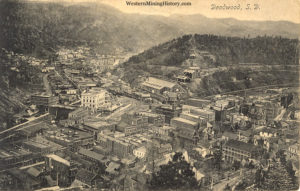 The history of Deadwood centers around discovery of gold in the southern Black Hills in 1874. This set off one of the great gold rushes in America, and in 1876, miners moved into the northern Black Hills. That’s where they came across a gulch full of dead trees and a creek full of gold and Deadwood was born. Practically overnight, the tiny gold camp boomed into a town that played by its own rules that attracted outlaws, gamblers and gunslingers along with the gold seekers. Wild Bill Hickok was one of those men who came looking for fortune. But just a few short weeks after arriving, he was gunned down while holding a poker hand of aces and eights. This hand has come to be known as the Dead Man’s Hand.
The history of Deadwood centers around discovery of gold in the southern Black Hills in 1874. This set off one of the great gold rushes in America, and in 1876, miners moved into the northern Black Hills. That’s where they came across a gulch full of dead trees and a creek full of gold and Deadwood was born. Practically overnight, the tiny gold camp boomed into a town that played by its own rules that attracted outlaws, gamblers and gunslingers along with the gold seekers. Wild Bill Hickok was one of those men who came looking for fortune. But just a few short weeks after arriving, he was gunned down while holding a poker hand of aces and eights. This hand has come to be known as the Dead Man’s Hand.
Calamity Jane also made a name for herself in these parts and is buried next to Hickok in Mount Moriah Cemetery. Other legends, like Potato Creek Johnny, Seth Bullock and Al Swearengen, created their legends and legacies in this tiny Black Hills town.
Deadwood has survived three major fires and numerous economic hardships, pushing it to the verge of becoming another Old West ghost town. But in 1989 limited-wage gambling was legalized and Deadwood was reborn.
Today, the town is booming once again. You’ll find modern-day casinos, resort hotels, full-service spas, big name concerts, and some of the best parties in the entire United States. You can walk in the footsteps of Deadwood’s legends and make history in Deadwood. They’ve been entertaining guests since 1876.
To get more information about Deadwood visit their web site: www.deadwood.com.
Old West Phrases
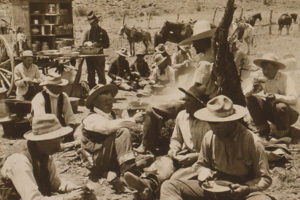 At Cowboy to Cowboy we get intrigued with Old West phrases. Here are some of our favorite descriptive terms:
At Cowboy to Cowboy we get intrigued with Old West phrases. Here are some of our favorite descriptive terms:
PRAIRIE TENOR – A coyote.
BARKIN’ AT A KNOT – Doing something useless.
WEARING THE BUSTLE WRONG – A pregnant woman.
ROUND BROWNS – Cow chips.
TEAR SQUEEZER – A sad story.
COLD AS A WAGON WHEEL – Dead
BEAR SIGN – Cowboy term for doughnuts. They were highly regarded.
SHAVE TAIL – A green, inexperienced person.
KICK UP A ROW – Create a disturbance.
THE WHOLE KIT AND CABOODLE – The entire thing.
BAZOO – Mouth as in “Shut your big bazoo.”
GONER – Lost, dead.
Kansas Trail Drives Come to an End
 It seems that Kansas had a love-hate relationship with Texas cattle and the cowboys that brought them up. The love part was the profits to be made providing supplies to the Kansas trail drives and a good time to trail-weary cowboys. Frontier struggling towns like Dodge City, Caldwell, Ellsworth, Hays, and Newton competed with Abilene to be the top “Cow Town” of Kansas.
It seems that Kansas had a love-hate relationship with Texas cattle and the cowboys that brought them up. The love part was the profits to be made providing supplies to the Kansas trail drives and a good time to trail-weary cowboys. Frontier struggling towns like Dodge City, Caldwell, Ellsworth, Hays, and Newton competed with Abilene to be the top “Cow Town” of Kansas.
But, as Kansas started getting less “frontier” and farming became more important, residents, anxious to attract businesses other than saloons and places of ill repute, started getting less enamored with the Texas cattle industry.
Although the Texas cattlemen tried to stay away from cultivated farmland, according to one cowboy “there was scarcely a day when we didn’t have a row with some settler.”
In addition to this, the Texas cattle carried a tick fever and hoof-and-mouth disease for which they were immune, but the Kansas cattle weren’t.
So, on this date back in 1885 the Kansas Legislature passed a bill that barred Texas cattle from the state between March and December 1.
This, along with the closing of open range with barbed wire fences, signaled an end to the cattle drives to Kansas.

